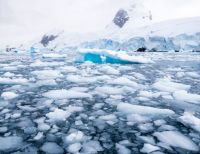Giving nature and the environment the same legal rights as humans is gaining ground as a new strategy to protect them from disaster.
If the environment had the same legal rights as a human being, would we continue to treat it with the same apparent contempt – destroying its habitats, polluting it with our waste, and exploiting its resources – all for short-term economic gain?
It is this line of thinking that is prompting communities and activists around the world to push for nature to be bestowed a type of ‘personhood’, to give it the same fundamental legal rights as people.
Two academics at UNSW Sydney who are watching this space with interest are Dr Marc De Leeuw and Scientia PhD candidate Alice Bleby of the Law & Justice faculty.
Dr De Leeuw, who specialises in the philosophical implications of new and evolving laws, says the ‘rights of nature’ movement is gaining momentum around the world.
“The rights of nature movement is an attempt to reimagine what law should be and what it stands for,” he says.
“Rights of nature makes a fundamental shift from human-focused law, where human rights are all about the rights of human beings, to the rights of nature, which also overcomes this fundamental binary in law between persons and things. It says that people can no longer own nature, and what makes up nature and the environment, are no longer seen as ‘things’.”
Dr De Leeuw says rather than relying on the actions of politicians and other law-makers, the rights of nature movement has a distinct grassroots flavour.
“It isn’t a top-down movement. It comes from communities who have often directly been impacted by environmental pollution, degradation or climate change, and were disappointed by more conventional environmental law approaches which have often been ineffective.”
Examples include the city of Toledo, Ohio in the US drawing up the Lake Erie Bill of Rights in 2019 after blue-algal blooms made the city’s water supply undrinkable some years prior; Ecuador recognising the rights of nature in its constitution in 2008; and the Whanganui River in New Zealand being granted legal personhood in 2017. And right now in The Hague, talks are underway about whether or not the North Sea can be considered a legal person.
Ms Bleby has studied the growth of rights of nature legislation in various parts of the globe that began in the early 2000s. She says fears about the looming climate catastrophe and despair at environmental disasters of humanity’s own making are spurring people on to effect change at the legislative level.
“There's a real sense that after 50 years of environmental law, it's failing to protect the environment,” she says.
“And so there’s a rethinking of what the law’s attitude to the environment is, and realising that what has been done to date has been about slowing down degradation and balancing various interests…But the rate of devastation that the planet is experiencing means that that's just not sufficient anymore. And so looking at rights, or personhood, is about elevating nature much higher in the hierarchy of priorities.”
Closer to home
While Australian laws have not progressed to the extent of granting personhood to various natural landmarks – perhaps because the nation doesn’t have a strong ‘rights’ culture, with no bill of rights in the constitution – moves are afoot at all levels of government to move down this path. In 2019 a report commissioned by the Australian Earth Laws Alliance recommended that the Great Barrier Reef be recognised with legal personhood, which would give it legal rights and protections under Australian law.
At the state level, in 2019 the NSW State Government passed a symbolic motion that recognised the rights of rivers and other waterways in the state. And in Western Australia, the Nyikina Mangala and Bunuba people submitted a proposal to the state government to recognise the Fitzroy River as an ancestral person in 2016.
Even local councils are getting in on the act: The Blue Mountains City Council passed a motion to recognise the rights of nature in 2020, declaring that “The Blue Mountains City Council recognises the inherent rights of nature to exist, thrive and evolve, and the interconnected relationships between all living beings and ecosystems”. And the Darebin City Council that looks after the outer suburbs of Melbourne made a similar declaration in 2018.
One size doesn't fit all
However, Ms Bleby says there is no one-size-fits-all approach when it comes to effecting change; each case has its own unique set of circumstances that targets laws at different levels.
“I think the ultimate goal is to recognise nature as a legal subject within a law of some kind – the more significant the law, the better.
“These laws can be made at a local, state, national or regional level, or even at the Constitutional level as they did in Ecuador. But a lot of the practical implementation obviously has to do with what's feasible within a jurisdiction, and also the type of community advocacy and the drivers in a particular context for recognising the law.”
Ms Bleby points to the Lake Erie Bill of Rights and the conferring of personhood status of the Whanganui River in New Zealand as two very different paths to enshrining protections for natural landmarks.
In the first, the laws came about largely due to community pressure after water was undrinkable for three days in Toledo, which was the final straw after decades of environmental pollution. But in the case of the Whanganui River in New Zealand, it sprang out of what Ms Bleby describes as the “deep culturally, and politically significant process of Treaty settlement negotiations under the Treaty of Waitangi”.
Five examples of ‘rights of nature’ law changes
Ecuador: In 2008, Ecuador became the first country in the world to recognise the rights of nature in its constitution. The country's constitution grants nature "the right to exist, persist, maintain and regenerate its vital cycles, structure, functions, and its processes in evolution".
Bolivia: In 2010, Bolivia passed a law that recognised the rights of Mother Earth, which is defined as a collective subject of public interest. The law recognises the rights of nature to life, regeneration, biodiversity, water, clean air, balance, and restoration.
New Zealand: In 2017, the Whanganui River in Aotearoa New Zealand was granted legal personhood, which means that it is recognised as a legal entity with its own rights and interests. The river is considered a sacred ancestor by the local Māori people.
Colombia: In 2018, the Constitutional Court of Colombia recognised the rights of the Atrato River, which is considered one of the most biodiverse regions in the world. The court ordered the government to take measures to protect the river, including cleaning it up and preventing further contamination.
India: In 2017, the Uttarakhand High Court in India recognised the Ganges and Yamuna rivers as legal entities with the status of "living entities". The court ruled that the rivers should be treated as "living human entities" and granted them legal rights and protection, although the decision is currently being appealed.
Full circle
One could argue that modern societies’ pursuit of rights of nature shows that we’ve come to the party quite late, since indigenous cultures around the world have largely been doing this for millennia.
“I think it's vital that Indigenous communities are involved in the development of these types of laws in Australia, they certainly won't realize their potential if they don't engage with Indigenous Australians and their views and perspectives,” says Ms Bleby.
“But I should note that not all Indigenous people support rights of nature, there's some persuasive academic writing on this from Aboriginal academics and others, who feel that it either doesn’t appropriately represent Indigenous views or feel there's a risk that Indigenous communities could be bypassed.
“So it's really important to recognise these views to ensure that it's not a perpetuation of a colonial legal framework, and to ensure it acknowledges the First Peoples’ long standing cultural connection to and knowledge about the environment and nature.”
Dr De Leeuw concurs:
“I think the indigenous perspective is very important in our move towards enshrining rights of nature in laws. We have to reimagine our fundamental legal concepts like property, or like nature.”
He says that in countries like New Zealand and Colombia, it has been easier to implement the rights of nature because it’s already part of the cultural imagination.
“But Australia is not there yet, there is a long way to go.
“Not only is the legal system not really set up to include a ‘rights for nature’ framework easily, but due to climate denial and big mining interests environmental action groups were sometimes criminalised and grass-root platforms – which also drive the ‘rights of nature’ movement - remained marginal.”
It has only been in recent years, Dr De Leeuw argues, that Australia has begun to develop a more substantial inclusion of Indigenous perspectives in its political and cultural self-understanding as a nation.
“To trigger serious debate and real inclusions of an effective ‘rights of nature’ position within our legal system, we need many things to come together!
“But if there’s no wish to go down that path, it will be very hard to actually realise anything like, for example, giving personhood to the Great Barrier Reef.”














